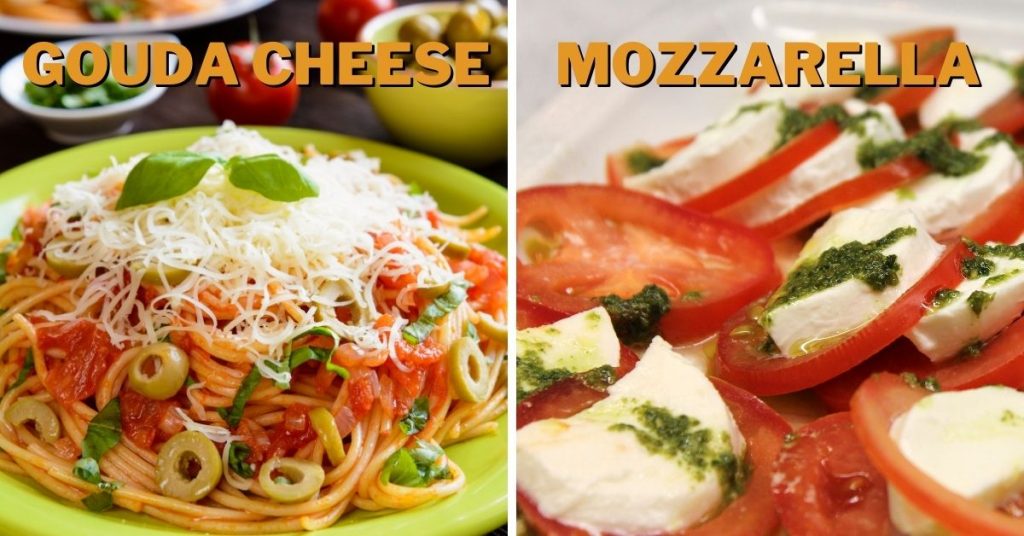Gouda vs. Mozzarella: Differences & Which Is Better?

Despite the fact that both Gouda and Mozzarella cheese are dairy products, there are some significant variations between them. Some recipes call for cheese, but you can’t be sure which type to choose sometimes. This is why you need to know the features of different types of cheese. So, what are the differences between Gouda and Mozzarella and when to use them?
Gouda is a wax-rind matured cheese from the Netherlands. Mozzarella is an Italian fresh cheese, which means it did not go through the curing (or aging) stage and should be consumed fresh. Mozzarella and Gouda can serve as substitutes for each other in meals like pasta and pizza. Mozzarella is used in salad, while Gouda isn’t.
You can mix Gouda for Mozzarella on occasion, but both types of cheese serve best on their own. If you’re still not sure why, continue reading this article to compare Gouda and Mozzarella side by side.
Gouda vs. Mozarella: Differences
Some of the cheese variances refer to their origin, taste and aging process, cooking methods, storage conditions, and nutritional content. Let’s talk about them in detail.
Origins
One big difference between Gouda and Mozzarella is their place of origin. Gouda cheese is a semi-hard Dutch cheese. We can trace its origins to the 12th century and the town of the same name in the Netherlands. Mozzarella is an Italian semi-soft curd cheese that, according to some sources, was developed in Sicily as far back as the 1st century AD.
Taste and Aging Process
Gouda has a delicate flavor that is mild and slightly nutty, making it ideal for pairing with dark chocolate and toffee. Younger Gouda is creamy and mild, and it goes well with beer, whereas older Gouda is sweeter and tangier, complementing wines that are deeply flavored, such as a rich Merlot or Shiraz.
To make Gouda, people usually use pasteurized cow’s milk. However, some producers opt for sheep’s or goat’s milk to make more bitter cheeses. In that cases, cheeses can be aged even up to seven years. At the same time, the majority of Gouda varieties are aged from one month to two years.
To keep the moisture inside, Gouda is usually coated with red or yellow edible paraffin wax.
On the other hand, Mozzarella is famous for its delicate, milky, and creamy flavor. It is traditionally made from water buffalo milk, but other types of milk are sometimes used as well. Fresh Mozzarella is typically white, but when seasoned, it can turn a light yellow depending on the animal’s diet.
It’s important to mention that, unlike many other types of cheese, Mozzarella is not left to age and should be eaten within a few hours after it’s made. Moreover, it will go bad quite fast if it’s not stored properly.
Melting Properties
The waxing on Gouda actually helps to keep the cheese moist inside by preventing it from drying out. It also has a high-fat content, which varies by milk source and can range from 25 to 35 percent. As a result, Gouda is an excellent melted and grilled cheese.
Melting Mozzarella, on the other hand, can occasionally be a difficult task. There are many different types of Mozzarella, and whether or not the cheese melts depends on its type and fat content. When Mozzarella melts, it does so in a different way than other cheeses, resulting in the cheese strings that we all enjoy so much.

Nutrition
At first glance, Gouda appears to have slightly more nutrients than Mozzarella in a single serving, most likely because Gouda is denser and has less moisture than Mozzarella.
However, fresh Mozzarella is considered to be one of the healthier cheeses on the market due to its low fat and salt content. [1] If you also remember that it contains a lot of protein, which is important for muscle growth, it’s no surprise that Mozzarella is often included in various diet plans.
Uses
Mozzarella is frequently used in pizza, tomato salad, and, of course, toasted sandwiches. When heated, this stretchy cheese flows out of the bread and adds a little wow element to your food. Not to mention, the mild, sweet, creamy flavor of Mozzarella complements heavy foods like potatoes and pasta.
Gouda is thick and solid, but it’s also creamy and less tangy than many other aged kinds of cheese. The natural sweetness complements pasta, carbonara, macaroni, spaghetti, or even desserts and fruit. Therefore, Gouda is pretty much a go-to cheese.

Preparation
The process of making Gouda begins with the addition of acid and rennet to raw milk to form curds, which are then washed with lukewarm water in order to help the cheese taste sweeter and creamier. Afterward, the curd blocks are wrapped in linen cloth and pressed into the mold.
Such cheese blocks are then transferred to soak in brine water for a few more days. Finally, once it is ready, the Gouda is coated with edible wax and stored.
Mastering the Mozzarella-making process takes years of practice. Preparation begins by heating milk with rennet to form curds, which are then separated from the whey. After that, the curd mass is drained, pressed, and cut into small chunks. The cheese curds soften in hot water in minutes, as if by magic.
The difficult part is when the curds do not form strings, which could be due to temperature or acidity. The kneading and pulling continue until the desired texture is achieved. After it’s made, fresh Mozzarella is kept in brine or oil.
Texture
The “pasta filata” production method, which means “spun paste” or “stretched curd” in Italian, is responsible for the distinctive texture and flavor of Mozzarella cheese.
Unlike Mozzarella, which has a doughy texture, Gouda is firm, smooth to cut, and will slightly stick to the knife when you cut it.
Gouda Vs. Mozarella: Which Is Better?
If you’re trying to lose weight, it’s good to know that Mozzarella has 20 fewer calories per serving than Gouda, and consuming the reduced-fat variety will save you even more. What matters the most, though, is your entire daily calorie intake and your dietary preferences.
So, if you prefer the taste of Gouda, go with it instead and alter the remainder of your food intake for the rest of the day to accommodate the extra calories.
Gouda Vs. Mozarella: Which Is Better for Pizza?
If you’re adding barbecued or smoked pork as well, Gouda is a good choice of cheese to add to your pizza. However, it’s best to combine it with other kinds of cheese in order to get the flavor that you want.
On the other hand, because of its light and creamy texture, Mozzarella cheese can be put on pizza on its own. In fact, it’s probably the most commonly used cheese for this purpose!
But instead of asking which cheese is better for pizza, why don’t you put both kinds on it and make it even more delicious? Do you know what they say? The more the merrier!
Can You Substitute Gouda for Mozarella?
Some of the main reasons why a Gouda cheese substitute may be necessary are that most families do not have it on hand on a regular basis, it might be too pricey for their monthly budget, or they just don’t like the taste of it.
However, you should know that cheeses are very complex when it comes to flavor and texture, so using the wrong cheese as a substitute even has negative implications for the outcome of certain recipes.
That being said, even though replacing Gouda with Mozzarella won’t have such dire consequences, it won’t be an easy choice since these types of cheese have largely different characteristics.
There are still a few cases when you can add Mozzarella instead of Gouda to your recipe. If you need a bit of smoked Gouda but you have none at hand, you’ll still want to go with a type of cheese that offers similar smoky features. For this purpose, smoked Colby, smoked Mozzarella, or young smoked cheddar will be ideal replacements.
